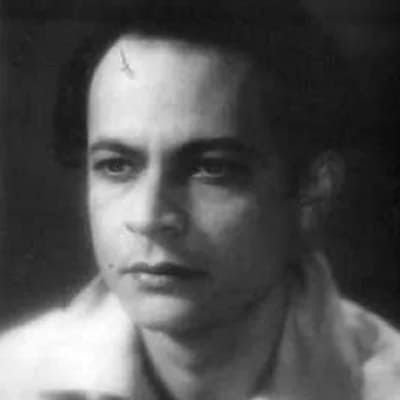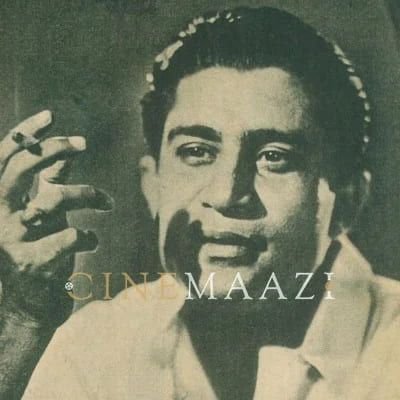Bijon Bhattacharya
Subscribe to read full article
This section is for paid subscribers only. Our subscription is only $37/- for one full year.
You get unlimited access to all paid section and features on the website with this subscription.
Not ready for a full subscription?
You can access this article for $2 , and have it saved to your account for one year.
- Born: 17 July, 1917 (Faridpur, Bangladesh)
- Died: 19 January, 1978
- Primary Cinema: Bengali
- Spouse: Mahashweta Devi
Legendary playwright, director, actor, script writer and political-activist, Bijon Bhattacharya was a man of many talents. Synonymous to his name is his play Nabanna (New Harvest), which has adapted many a times in various languages.
Born into an influential family of Brahmin landlords, in Faridpur (now a part of Bangladesh), to parents Khsirodbihari and Suvarnaprabha, Bijon was highly influenced by the socio-political movements of the time and was always an active participant. It was during the Civil Disobedience Movement of 1930 that Bijon shifted to Kolkata and discontinued his Masters. During his tenure at Ripon College he came in contact with the leftist ideology and was stirred intellectually as well as ideologically. He remained an ardent leftist till the final period of his life and most of his work was a reflection of the same. His association with Progressive Writer’s Association, formed in 1936, resulted in his meeting with the prolific novelist and short story writer Mahasweta Devi, with whom he later got married in 1947.
Bijon’s magnum opus Nabanna was a result of the Bengal famine of 1943. A direct result of World War II, and the policiies of the British government, the famine of 1943 was one of the worst man-made famines in the world which killed around three million people. Amid such volatile conditions the Indian People’s Theatre Association (IPTA) was formed on 25th May, 1943 of which Bijon was a founding member. His play Nabanna marked a break from commercial stage and the inception of an activist, amateur theatre. It was first staged by IPTA in 1944 under the direction of Sombhu Mitra with Bijon as the main actor. During his association with IPTA he wrote plays such as Jabanbandi (1943), Agun (1943), Jiyon Kanya (1945), Abarodh (1946), and Mora Chand (1947). He left IPTA in 1948 due to difference of ideologies and opinions with his associates. His later plays include Devgarjan (1966), Garbhabati Janami (1969), Sonar Bangla (1971), Chalo Sagare (1971) and Haanskhalir Haans (1977).
His plays travelled beyond the borders of Bengal and were translated in different languages or adapted as short stories. The film Dharti Ke Lal (1946), directed by Khwaja Ahmed Abbas germinated from his play Nabbana. Bijon co-wrote the script with K A Abbas. Along with his association with theatre Bijon Bhattacharya was also an actor and script writer for films. His most major collaboration in cinema has been with Ritwik Ghatak, with whom he worked in films like Bari Theke Paliye (1958), Meghe Dhaka Tara (1960), Komal Gandhar (1961), Subarnarekha (1965) and Jukti Taako Aar Gappo (1974).
Bijon often took the role of the stereotype-usually an idealistic school teacher from East Bengal, speaking a dialect from that part of country. While in the old Bengali theatre, the highly affected style of dialogue delivery by such characters became a cliché, in Ritwik’s films the same style, used at decisive moments, ignited a spark in the minds of the audience. His sudden appearance as the ghost-like face of Haraprasad (Bijon Bhattacharya) peeping through the window in Subarnarekha with his question (in typical East Bengali dialect) aimed at Iswar (Abhi Bhattacharya)- “How old is the night?” is one of the most unforgettable moments of cinema history.
His other films include Tathapi (1950), Chinnamul (1950), Padatik (1973) and Sharey Chuattor (1953). Bijon drew immensely from the folk traditions in his work in both theatre and cinema as he noticed many latent possibilities of the traditional folk and musical forms.
Bijon’s marriage with Mahasweta Devi did not last long as the couple struggled to make ends meet. Their only child Nabarun Bhattacharya, a celeberated writer and novelist, was brought up by Bijon single-handedly. His passion for theatre and his commitment to the art form led to his tragic and untimely demise. It was during the staging of his play at Mukta Manch in 1978 that a nail pierced his foot while he continued with his performance. By the end of the play blood was oozing out of his foot. The injury turned out to be fatal as Bijon vomited blood the following night and left the stage and this world on 19 January, 1978.






.jpg)



